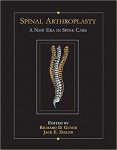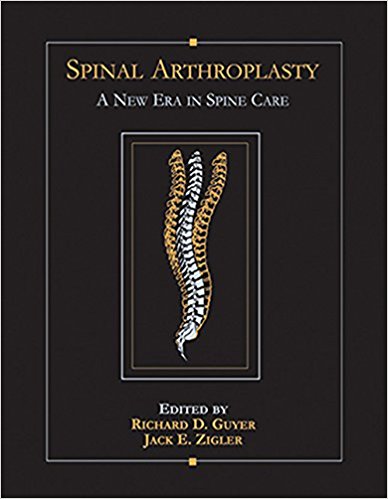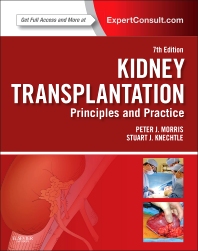 Editors: Richard D. Guyer, MD; and Jack E. Zigler, MD
Editors: Richard D. Guyer, MD; and Jack E. Zigler, MD
Publisher: Thieme – 343 pages
Book Review by: Nano Khilnani
This is a book about something that has created a lot of excitement and buzz among spine and orthopedic surgeons, as well as among patients with chronic back pain. It is about the treatment of disc-related pain, including the total replacement of a disc with an artificial or man-made disc.
Artificial disc replacement (ADR) or total disc replacement TDR) is a type of arthroplasty in which the degenerated intervertebral disc in the spinal column is replaced with an artificial or man-made device in the lumbar (lower) or cervical (upper) spine. Cervical disk replacement is also an alternative intervention for symptomatic disc herniation.
Replacement of a degenerative or herniated disc with an artificial one has been developed as an alternative to spinal fusion. Spinal fusion procedures have become quite common. The goal of spinal arthroplasty (ADR or TDR) is to either reduce pain greatly or if possible, to eliminate the pain, while still allowing motion throughout the spine.
Thirty-one specialists in neurosurgery, spine and orthopedic surgery, from all over the United States and three other countries – France, Germany, and the United Kingdom – authored the 18 chapters of this book. We name the titles of the chapters below to provide you an overview of this book’s contents:
- Part I.. Fundamentals
- Evolution of the Treatment of Lumbar and Disc-Related Pain
- History of the Artificial Disc
- Indications and Contraindications for Total Disc Replacement
- Psychological Evaluation of Spinal Arthroplasty Patients
- Part II. Biomechanics and Development
- Design Goals for an Invertebral Prosthetic Disc
- History and development of the Charite Artificial Disc
- ProDisc: Design and Clinical Benefits
- Development of Disc Nucleus Replacement
- Part III. Techniques and Technologies
- Anterior Approach to the Lumbar Spine
- Dynamic Stabilization Devices for the Treatment of Low Back Pain
- Microsurgical Anular Reconstruction (Anuloplasty) Following Lumbar Microdiscectomy
- Total Disc Replacement Implants and Clinical Results
- Total Disc Arthroplasty Using Maverick Total Disc Replacement
- The Porous Coated Motional Cervical Disc Replacement
- Cervical Arthroplasty with a Multifunctional Prosthesis
- Total Facet Replacement
- Part IV. Future Considerations
- Biologic Disc Repair
- The ‘Smart” Intervertebral Disc
“Only once since the mid-1980s has progress been made for the spine,” writes Dr. Stephen Hoschschuller, chairman of the Texas Back Institute in his Foreword. That was when Drs. Kurt Schellnack and Karin Buttner-Janz in Berlin designed the first clinically viable total disc replacement.”
Dr. Hoschschuller points out that Texas Back Institute’s interest in artificial discs began in the 1990s when Dr. Buttner-Janz visited this institute. It was followed by researchers who went to Europe to look at the results at several centers that were using the device. These experiences confirmed their enthusiasm for spinal artthroplasty. They worked with the Link Company to bring the technology to the United States.
The first Charite device was implanted into a patient in March 2000, and this was followed by the first ProDisc device implantation in October 2001. Surgeons at the Texas back Institute have since then been actively involved in evaluating three of the four replacement disc devices undergoing FDA study, as well as with the evaluation of cervical total disc replacements.
Five artificial discs have been approved by the FDA so far: the Charite, the ProDisc, the Prestige Disc, the Moby-c Disc, and the active disc.
“Spinal arthroplasty represents a long-awaited advancement in the care of patients with back pain. The development and use of motion-retaining spinal implants represent one of the greatest innovations in spine care surgical treatment,” write Drs. Richard Guyer and Jack Zigler, the editors of this book, in the Preface.
An interesting portion of this book is chapter 9 entitled Anterior Approach to the Lumbar Spine, authored by Salvador A. Brau.
He begins with introductory remarks, then discusses the following points in this particular surgical approach:
- General Considerations
- Surgical Technique (accompanied by 18 photographs and sketches)
- Conclusion
- References
Total replacement of degenerative discs with artificial or man-made ones as an innovation mode for the relief of chronic back pain is just a few decades old, and this pioneering text book is your comprehensive guide to much of the information relating to the safe and successful procedures in this field.
Editors:
Richard D. Guyer, MD, FAAOS is Co-Found3r of the Texas Back Institute, Co-Director of the Spine Fellowship Program at Texas Back Institute in Plano, Texas, and Associate Clinical Professor in the Department of Orthopedic Surgery at the University of Texas Southwestern School of Medicine in Dallas, Texas.
Jack E. Zigler, MD, FACS, FAAOS is Co-Director of the Spine Fellowship Program at Texas Back Institute in Plano, Texas, and Associate Clinical Professor at the University of Texas Southwestern School of Medicine in Dallas, Texas.







